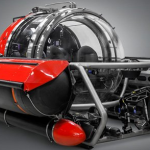David Aldridge is a phytoplankton-loving marine biology PhD student at the National Oceanography Centre in Southampton, UK. Also the founder and editor of Words in mOcean, a website dedicated to publishing blog posts and features on marine science. We’ve asked David to guest post for us here at DSN. Enjoy!
So, Republicans and Democrats entered into a giant game of chicken with the US’s finances and now science funding will be slashed faster than Usain Bolt sprinting down an airport walkway. It is a good thing that marine science is cheap to carry out, with very little infrastructure, equipment, publication and travel costs. Oh wait, that’s not right, is it. We’re all screwed… or are we? Follow these money saving tips (most of which involve some sort of human rights violation against grad students) and you may just make it through unscathed:
One man research vessels
In the UK, it appears that we have already started using swimmers fitted with sensors for collecting oceanographic data. In the future, many of the best oceanographers will clearly be super-fit ‘one man research vessels’. You need to get ahead of the game, start going to your local swimming pool before and after work, and train your ass off! What’s that you say? “I’m a senior professor and I can’t even climb a flight of stairs without breaking into a deluge of sweat, how am I supposed to swim thousands of miles?” I have one word for you: Grad students. Just remember to test their swimming capabilities on interview day — or better yet, only interview candidates who have Olympic medals in long distance swimming events. For large, cumbersome lab equipment, you may also want to invest in a raft of undergraduates (pictured below supporting a flow cytometer).


CTD rosette on a budget
The cost of a full sized CTD is about $500,000 and has to be shared with a whole group of other annoying scientists (and if American TV has taught me anything, it is this: sharing = communism). A good dive computer will monitor temperature and depth whilst only setting you back a couple hundred dollars. Tape this to a salinity probe (a few hundred dollars) and a bunch of used soda cans, and you have saved yourself over $499,000. This thing will also be far more lightweight than a real CTD — something your grad student will appreciate as they haul it across the ocean on their back.
ROV for almost free
Take one brave (and preferably pressure resistant) volunteer (grad student), equip with a (very) waterproof camera, attach ball and chain to ankle, and wait for the photographs of the deep-sea to come flooding in. Retrieval of the ‘volunteer’ may be somewhat problematic, but try not to let them know that. To make sure that their sacrifice isn’t for nothing, attach the camera to a long piece of string in order to allow recovery of the photos. Failing this, we will all just have to wait for James Cameron to donate a deep-sea submersible to our department… I wouldn’t hold your breath though. (You may suffer the same fate as your grad student!).
‘Open access’ publication

You spent years writing and editing a paper and sent it to a journal, who will now sell it back to your fellow academics for a small fortune. Unless of course you stump up some hard cash yourself and make it open access. Hardly fair is it? You do all the hard work, and then some (unpaid) intern does 3 hours of ‘formatting’, and the publishing company that he works for makes a killing!
What to do then? You could try to publish a whole journal article on your blog, but you would probably end up infringing on some sort of copyright (of your own damn work!). But why not make your work open access by publishing it 140 characters at a time on Twitter… your followers will love you for this! (Who doesn’t love having their Twitter feed being taken up by a single person?).
Travel to conferences
Isn’t it obvious? Travel on the back of your ‘one man research vessel’, or float there at your leisure on your ‘raft of undergraduates’.
Share the post "Ways for marine scientists to save money and beat the budget sequester"








I could float to the conference I’m attending in Baltimore, but travel to Albuquerque via raft would be a challenge. Any tips?
Luckily, the ‘raft’ has feet, so is also suitable for land. Just allow plenty of travel time…
If your pool of willing undergraduates filor the raft is running low, just post online about this great new opportunity to contribute to marine science, network and gain experience and you will have buckets of graduates competing for a place on your rafts next voyage. Just a thought…
Oh, this was delightful — thanks for brightening my day. Who says invasive Japanese sea creatures are the only ones who can raft their way to success?